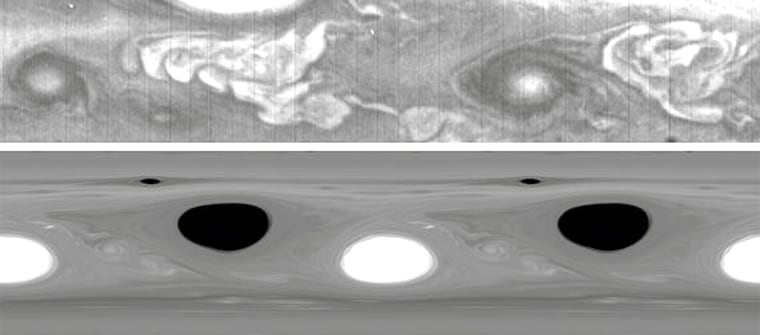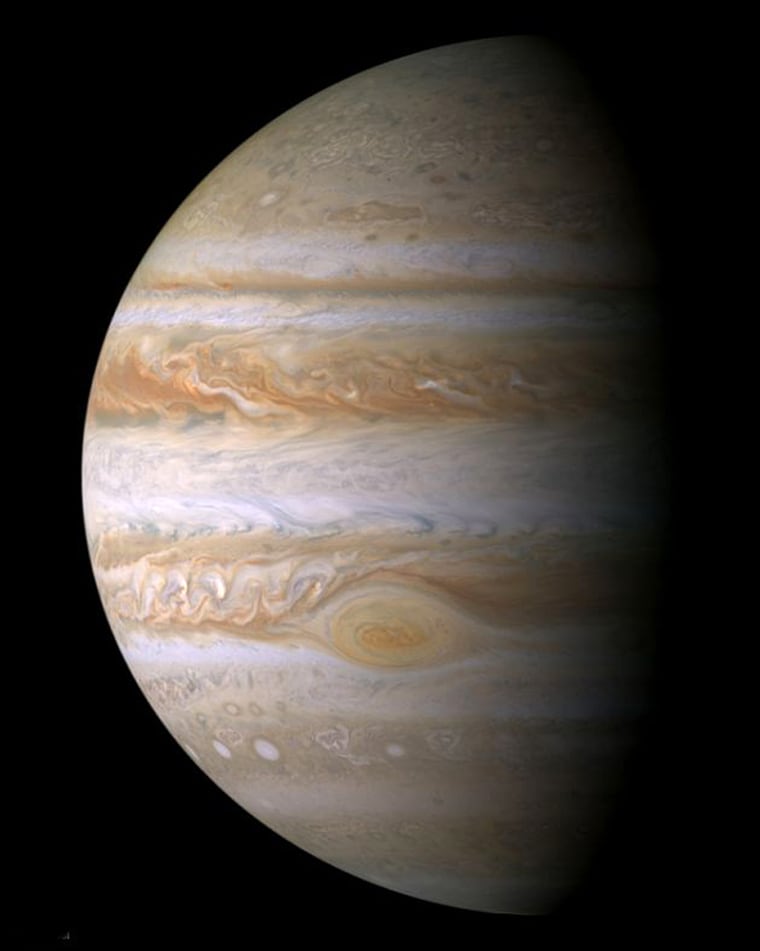Jupiter is undergoing major climate change and could lose many of its large spots over the next seven years, only to make way for the creation of fresh spots in a decades-long cycle, according to a new explanation of old mysteries.
While the analysis remains to be proven, it is seen by other researchers as interesting and, importantly, testable even with large backyard telescopes.
Philip Marcus, a professor at the University of California at Berkeley who came up with the idea, is an expert in fluid and atmospheric dynamics. He has never seen Jupiter through a telescope. But his computer modeling, reported in Thursday's issue of the journal Nature, accounts for previously noted disappearances of large white spots, and it makes predictions that can easily be verified or refuted.
Experienced backyard astronomers should be able to witness the forecasted changes, which include color shifts that might even alter the look of the centuries-old Great Red Spot, the mother of all storms in our solar system.
Marcus bases his prediction in part on the observed appearance of three large white ovals, all thousands of miles across, on Jupiter in 1939, and the unexpected disappearance of two of them between 1997 and 2000, during which time they all merged into one.
Other smaller spots have gone away since.
Marcus says the demise of still more spots over the next seven years will mark the end of a newly proposed, 70-year climate cycle.
During this time, Jupiter's equatorial region will warm up a whopping 18 degrees Fahrenheit (10 Celsius) and the planet will grow cooler near the poles. Then the stage will be set, as in 1939, for another batch of white ovals to appear dramatically by 2014.
What's going on
In a telephone interview, Marcus told Space.com how he thinks the changes are related to alternating periods of atmospheric calm and chaos.
Jupiter's spots are swirls of air called vortices, which stir up different chemical mixes to make themselves lighter or darker and of varying colors. They all march around the planet embedded in rotating cloud bands, akin to Earth's jet streams. Jupiter has about a dozen of these bands going east and a dozen heading west, moving in excess of 300 mph (482 kilometers per hour).
"Between those there's a lot of shear," Marcus explained. "And vortices thrive in that kind of environment."
Among the most pronounced of these vortices were the three largest white ovals, rotating counterclockwise in the southern hemisphere and called anticyclones.
In 1979, the Voyager spacecraft identified, for the first time, hundreds of smaller vortices, by Marcus' measure. "They always had brothers and sisters," he said. "When you saw one anticyclone, you'd see others at the same latitude." Marcus tried to create mathematical models for generating so many anticyclones in close proximity. On Earth, vortices of the same flavor — such as two low-pressure systems or, alternately, a pair of high-pressure systems — tend to rotate around one another without necessarily destroying one another.
"I failed miserably, because all of the vortices in a row would quickly merge into one giant vortex," Marcus said of his early models.
Invisible cyclones
Finally he figured a way to simulate the setup.

In between every two anticyclones, he inserted a cyclone, a region that rotates in the opposite direction. The opposing pairs move along what's known as a von Karman vortex street, a well understood phenomenon in fluids and the atmosphere of Earth. The virtual Jovian whirls began to hum like well-oiled gears.
"It's an extremely stable configuration," Marcus said.
Problem was, no one believed there were long-lived cyclones on Jupiter, and other scientists didn't believe they existed. Voyager had found cyclones, but because their associated clouds were tangled and disorganized, they were either not identified as vortices or were considered transients that could have no long-term influence.
Then in 1994 the Hubble Space Telescope witnessed two anticyclones that should have repelled one another instead traveling together.
"This really bugged me," Marcus recalls. "I couldn't figure out what the heck was going on."
With some more modeling, he realized that jet streams — the cloud bands — can develop waves. On Earth, these waves, or troughs, can capture system after system and usher them into, say, California, in a weeks-long series of storms. On Jupiter, a wave can trap two anticyclones with a cyclone sandwiched between.
"Then any little perturbation can trip the balance and cause the two anticyclones to merge," Marcus realized. That's what he thinks happened to the three large white ovals that joined up a few years back.
'Serious' climate change
The mergers are part of a significant climate change Marcus thinks is imminent. Unlike Earth, Jupiter's equator is not much warmer than its poles, even though the equator receives more sunlight. That implies that something is globally mixing the heat pretty effectively, Marcus explains. (Another factor is that Jupiter generates much of its heat from within.)
The vortices play a role, he thinks, with chaos as a supporting actor. Imagine putting dye in a cup of water. It doesn't mix well. But shake the cup — introduce some chaos — and the dye mixes easily. The vortices create chaos that extends from the visible surface down into Jupiter's hidden belly.
As more vortices on Jupiter merge, a period of calm will set in, reducing the mixing of atmospheric heat.
"If you knock out a whole row of vortices, you stop all the mixing of heat at that latitude," Marcus reasons. "This creates a big wall and prevents the transport of heat from the equator to the poles." He notes that the predicted equatorial warming of 18 degrees Fahrenheit dwarfs any climate changes measured on Earth.
"This is a serious change," he said. "It's nice to have another laboratory to look at global climate change. Perhaps we can learn something."
Peter Gierasch, a Cornell University astronomer who has modeled Jupiter's weather but was not involved in the new work, notes that heat is behind all of the cloud dynamics on Jupiter.
Marcus' modeling represents "the first time that the heating has been coupled to the vortex dynamics," Gierasch told Soace.com. "That's a step forward."
Soon the temperature increase is expected to fuel a fresh round of chaos within the jet streams.
"You take these nice happy jet streams and make them unstable," Marcus said. "Waves form. Like waves on a beach, they break." But there's a difference between an ocean and an atmosphere with no shores. The Jovian waves will roll up and produce new, large vortices, repopulating Jupiter with new spots for skywatchers to discover.
Marcus offers a specific location for seasoned amateur astronomers to watch for change starting right now. At about 41 degrees south latitude, Voyager saw 12 distinct white ovals. Now there are fewer, he said, and more should disappear over the next seven years.
Partial immunity
Jupiter's Great Red Spot is a different beast. It's the largest, at 12,500 miles (20,120 kilometers) wide and was discovered around 1665, having now outlived all other spots. It rumbles around the planet near the equator, in what Marcus calls a "kill zone" of inactivity.
"The Red Spot is very odd, because it's not in a row of vortices," he said. "It's all by itself. So the Red Spot just goes around eating its neighbors no matter what happens."
But if the equatorial region warms as Marcus predicts, the biggest of all spots could take on a different appearance. Over the past 300 years it has changed color several times and recently altered from its traditional red to something more like salmon. Scientists aren't sure why, but it likely involves redistribution of chemicals, with underlying layers becoming exposed.
"If you heat it up, you may well change the color," Marcus said. On his Web site are animations showing how cyclones and anticyclones on Jupiter interact.
